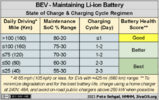3. Shallow charge and discharge (55-35 or 55-30 SoC), if feasible for routine driving, is the best option for a long battery life.
The lower the SOC range, the better.
If the range + range anxiety allows, charge only to 50%.
I did select 55% as it is a reasonable compromise between low degradation and range. But using 50% as the charging target (as no lower setting exist) is better than 55% in terms of degradation only.
If there was an option to charge to 30% or 40% this would probably be the best if this is enough ( which it is for many peoples daily drive).
If I did not miss-read the post, you did not write about charging late.
The
55% or less is coupled to calendar aging, and calendar aging will be very much reduced by charging shortly before the drive.
If there is a need to charge to for example 80% or 90%, the very most part of the calendar aging is avoided by charging late.
In short, charging higher than 55% if needed isnt that bad if the time at high SOC is short.
5. Normally, an idle Tesla consumes 6-10% of its battery every day. If you put it in Sentry Mode or Dog Mode, it's closer to 1% every hour.
5kWh / day for sentry = 7-8% for an LR and 10-isg for an SR.
Sentry and cabib overheat protection of, one percent or so each week.
For the picture, it is a risk of being taken as the ”true values”. This is very common.
Because of this its important that the pictures presented is not missleading.
For the examples of daily drive, they might be missleading.
The basics is:
-Only charge to the level needed until the next charge.
-Charge often (daily for most people)
-Charge late
This means that as long as 50% charging target is enough (including a safe margin) use 50%.
For the table, the ”Mainenance SOC range” does not feel the best.
Any of the 120km or less should be charging to 50% and the arrival SOC should be whatever it happens to, be.
If this means it is lower than the personal comfort zone, raise the target to what feels safe/good.
There is no reason coupled to the battery to stay above 20%. The lower limit should perhaps not be written as it most probably will be taken as a qualitative number fir what is best for the battery.
For example the <100mi (160km), 55-15% will keep the battery at and below the 55% limit which will reduce the degradation most.
I get 200km range with my M3P and 50% SOC at the average lifetime consumption.
For any drive less than about 180km I could use 50% charging, as it would give the lowest degradation. 55-15 or 50-10% will be much better than 80-40%
For <75miles, 50-20% is much better.
The Cyclic degradation is
very small compared to the calendar aging, so we do not really need to use that as a factor for planning the SOC level. In any case they are about the same, low SOC + charge late is most important. Small cycles is also good but not most important.
So, to increase the life of the battery, it is the time at high SOC that is the most important thing. Any action that ends up in having low SOC for the biggest part of the day is good.
For the charging, it should state that any AC charging is good form the battery.
If using the charge late strategy, the highest possible AC power gives the shortest time at high SOC, but if the charging is not ”late” a lower power is better as it delaya the high SOC.
For fast chargers, the limit should not be set to ”above 150kW” but instead maybe above 50-80kW.
My personal tip after reading research about fast charging is to always precondition the battery when possible.
I always do that.



